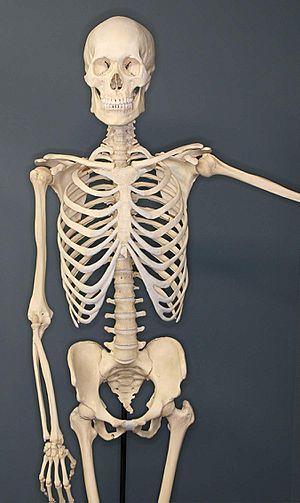Human skeleton facts for kids
The human skeleton is the internal framework of the body. It is made up of about 300 bones at birth. As some bones join together, there are 206 bones in adulthood. The bones are at their stongest around age 20. The human skeleton can be divided into the axial skeleton and the appendicular skeleton. The axial skeleton is formed by the vertebral column, the rib cage, the skull and other associated bones. The appendicular skeleton, which is attached to the axial skeleton, is formed by the shoulder girdle, the pelvic girdle and the bones of the upper and lower limbs.
The human skeleton performs six major functions. These are: support, movement, protection, production of blood cells, storage of minerals, and endocrine regulation.
The male and female skeletons are not so different as those of many other primates. There are subtle differences between sexes in the morphology of the skull, teeth, long bones, and pelvis. In general, female skeletal elements tend to be smaller and less robust than corresponding male elements.
The human female pelvis is different from that of males in order to facilitate child-birth. The hips on a female are proportionately wider than males, and so the ball joints at the top of the legs are set more apart than in males. This, and the pelvic shape, gives a birth channel which allows the newborn foetus to pass through. The critical factor is the baby's head, which is much larger than in other primates.
Unlike most primates, human males do not have penile bones. This is an adaptation to the human upright stance.
Contents
Functions
The skeleton serves six major functions: support, movement, protection, production of blood cells, storage of minerals and endocrine regulation.
Support
The skeleton provides the framework which supports the body and maintains its shape. The pelvis, associated ligaments and muscles provide a floor for the pelvic structures. Without the rib cages, costal cartilages, and intercostal muscles, the lungs would collapse.
Movement
The joints between bones allow movement, some allowing a wider range of movement than others, e.g. the ball and socket joint allows a greater range of movement than the pivot joint at the neck. Movement is powered by skeletal muscles, which are attached to the skeleton at various sites on bones. Muscles, bones, and joints provide the principal mechanics for movement, all coordinated by the nervous system.
It is believed that the reduction of human bone density in prehistoric times reduced the agility and dexterity of human movement. Shifting from hunting to agriculture has caused human bone density to reduce significantly.
Protection
The skeleton helps to protect our many vital internal organs from being damaged.
- The skull protects the brain
- The vertebrae protect the spinal cord.
- The rib cage, spine, and sternum protect the lungs, heart and major blood vessels.
Blood cell production
The skeleton is the site of haematopoiesis, the development of blood cells that takes place in the bone marrow. In children, haematopoiesis occurs primarily in the marrow of the long bones such as the femur and tibia. In adults, it occurs mainly in the pelvis, cranium, vertebrae, and sternum.
Storage
The bone matrix can store calcium and is involved in calcium metabolism, and bone marrow can store iron in ferritin and is involved in iron metabolism. However, bones are not entirely made of calcium, but a mixture of chondroitin sulfate and hydroxyapatite, the latter making up 70% of a bone. Hydroxyapatite is in turn composed of 39.8% of calcium, 41.4% of oxygen, 18.5% of phosphorus, and 0.2% of hydrogen by mass. Chondroitin sulfate is a sugar made up primarily of oxygen and carbon.
Endocrine regulation
Bone cells release a hormone called osteocalcin, which contributes to the regulation of blood sugar (glucose) and fat deposition. Osteocalcin increases both the insulin secretion and sensitivity, in addition to boosting the number of insulin-producing cells and reducing stores of fat.
Images for kids
-
During construction of the York to Scarborough Railway Bridge in 1901, workmen discovered a large stone coffin, close to the River Ouse. Inside was a skeleton, accompanied by an array of unusual and expensive objects. This chance find represents one of the most significant discoveries ever made from Roman York. Study of the skeleton has revealed that it belonged to a woman.
See also
 In Spanish: Esqueleto humano para niños
In Spanish: Esqueleto humano para niños



